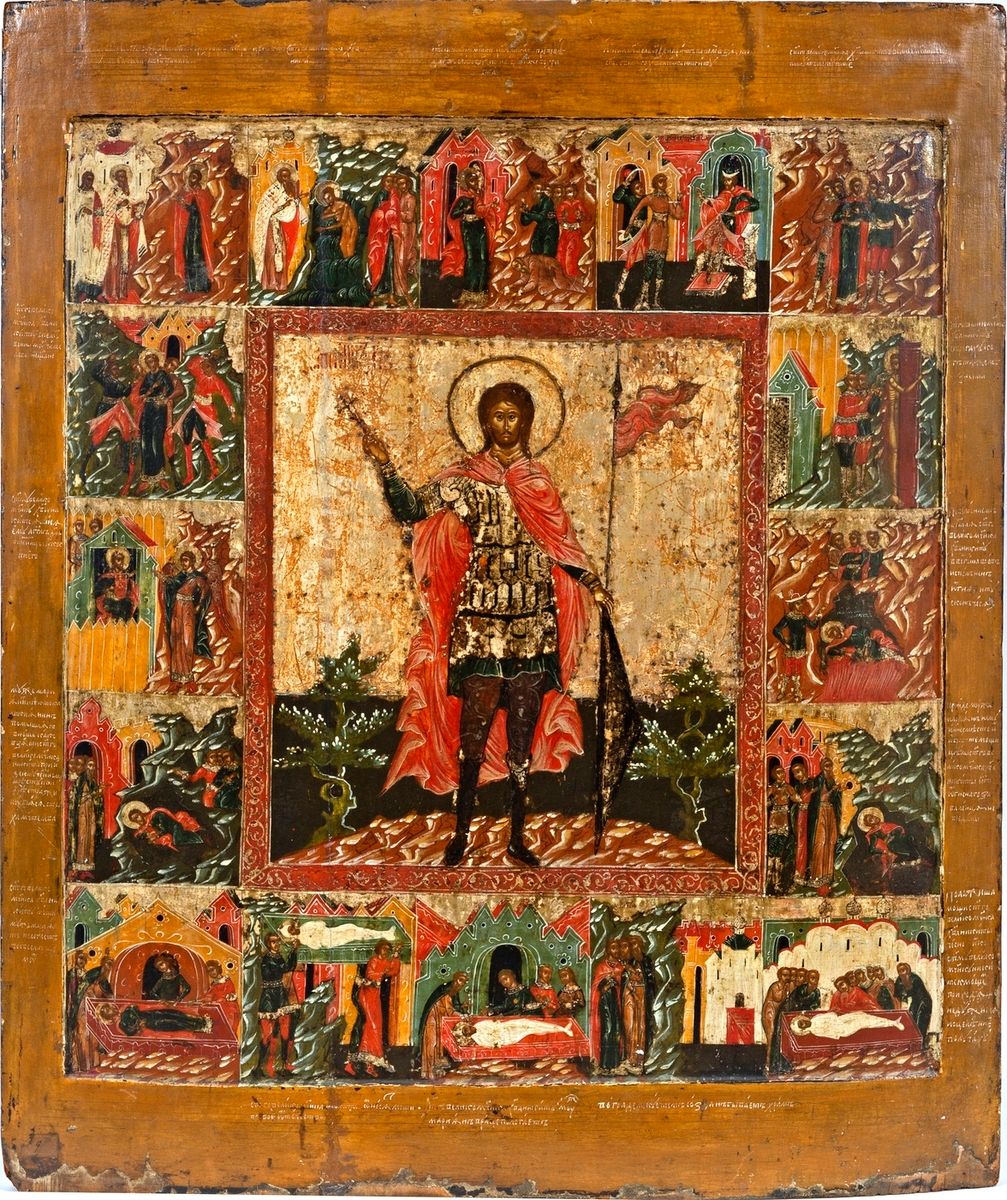Description
Rare and important icon of the blessed and great martyr Nikita (Nicetas the Goth). Tempera on wood In the center a full-length representation, surrounded by 16 scenes of his life in cantons. Restorations and wear, slight lacks. The legends added later. Russia, Novgorod school, 17th century 90,5 x 75,5 cm Provenance: - Otto-O'Méara and his wife née Moselli Collection - Their sale, Galerie Georges Giroux, Brussels, 15-16-17 October 1928, lot 304 (reproduced in the catalogue under n°94) - Private collection, Belgium From Otto-O'Méara's important collection of icons, one of only two that existed outside of Russia, export of which was prohibited to the West at the time, this work was part of the series of exceptional pieces from the Novgorod school. Historical background: Nicetas the Goth (Greek: Νικήτας) was a Christian martyr who died in Romania in the year 372, recognized as a saint and venerated by both Catholics and Orthodox. A Goth by origin, Nicetas was born and lived on the banks of the Danube. He was baptized by Bishop Theophilus, who participated in the first Council of Nicaea (hence his baptismal name). Together with the Greek-born Goth bishop Ulfila, he evangelized his fellow Goths, most of whom were followers of Arianism. As a soldier, Nicetas fought against the pagan troops of Athanaric. When Athanaric came to power among the tribes of the region, he systematically persecuted the Christians. Nicetas was condemned to the stake in 372, but his body was not burned completely. His remains were collected by another Goth soldier friend of the Christian religion, Marian (Marianus), who later brought his body, preserved from the fire, to Mopsueste in Cilicia, where a church was built for him and many miracles were performed (legend marked on the bottom of the icon). Some of his relics were later given to churches in Constantinople, and from there to the monastery of Vissoki Detchani (Serbia). He is the patron saint of the town of Melendugno in Italy, where the 12th-century abbey preserves a relic. Several churches and monasteries in Russia are dedicated to him, such as the Nikitsky monastery in Pereslavl-Zalesski, the Nikitsky monastery destroyed in the 1930s in Moscow, etc. His feast day is September 15 in the Gregorian calendar for the Latins and September 15 in the Julian calendar (i.e. September 28 in the Gregorian calendar) for the Eastern Orthodox Churches. The Russian variant of his name, Nikita (Никита), is common in Russian-speaking countries. This lot is described by Maxime Charron, Paris.
136
Rare and important icon of the blessed and great martyr Nikita (Nicetas the Goth). Tempera on wood In the center a full-length representation, surrounded by 16 scenes of his life in cantons. Restorations and wear, slight lacks. The legends added later. Russia, Novgorod school, 17th century 90,5 x 75,5 cm Provenance: - Otto-O'Méara and his wife née Moselli Collection - Their sale, Galerie Georges Giroux, Brussels, 15-16-17 October 1928, lot 304 (reproduced in the catalogue under n°94) - Private collection, Belgium From Otto-O'Méara's important collection of icons, one of only two that existed outside of Russia, export of which was prohibited to the West at the time, this work was part of the series of exceptional pieces from the Novgorod school. Historical background: Nicetas the Goth (Greek: Νικήτας) was a Christian martyr who died in Romania in the year 372, recognized as a saint and venerated by both Catholics and Orthodox. A Goth by origin, Nicetas was born and lived on the banks of the Danube. He was baptized by Bishop Theophilus, who participated in the first Council of Nicaea (hence his baptismal name). Together with the Greek-born Goth bishop Ulfila, he evangelized his fellow Goths, most of whom were followers of Arianism. As a soldier, Nicetas fought against the pagan troops of Athanaric. When Athanaric came to power among the tribes of the region, he systematically persecuted the Christians. Nicetas was condemned to the stake in 372, but his body was not burned completely. His remains were collected by another Goth soldier friend of the Christian religion, Marian (Marianus), who later brought his body, preserved from the fire, to Mopsueste in Cilicia, where a church was built for him and many miracles were performed (legend marked on the bottom of the icon). Some of his relics were later given to churches in Constantinople, and from there to the monastery of Vissoki Detchani (Serbia). He is the patron saint of the town of Melendugno in Italy, where the 12th-century abbey preserves a relic. Several churches and monasteries in Russia are dedicated to him, such as the Nikitsky monastery in Pereslavl-Zalesski, the Nikitsky monastery destroyed in the 1930s in Moscow, etc. His feast day is September 15 in the Gregorian calendar for the Latins and September 15 in the Julian calendar (i.e. September 28 in the Gregorian calendar) for the Eastern Orthodox Churches. The Russian variant of his name, Nikita (Никита), is common in Russian-speaking countries. This lot is described by Maxime Charron, Paris.
